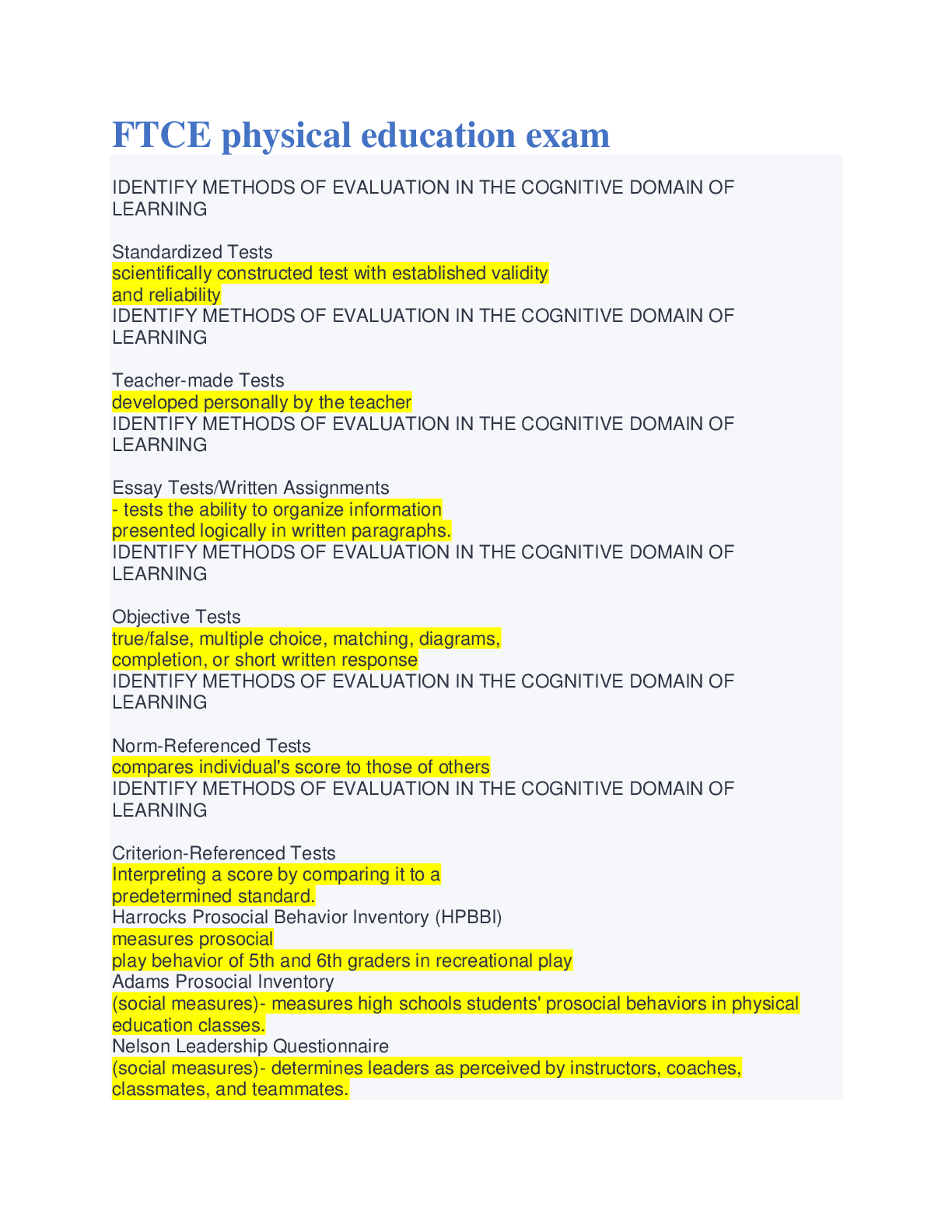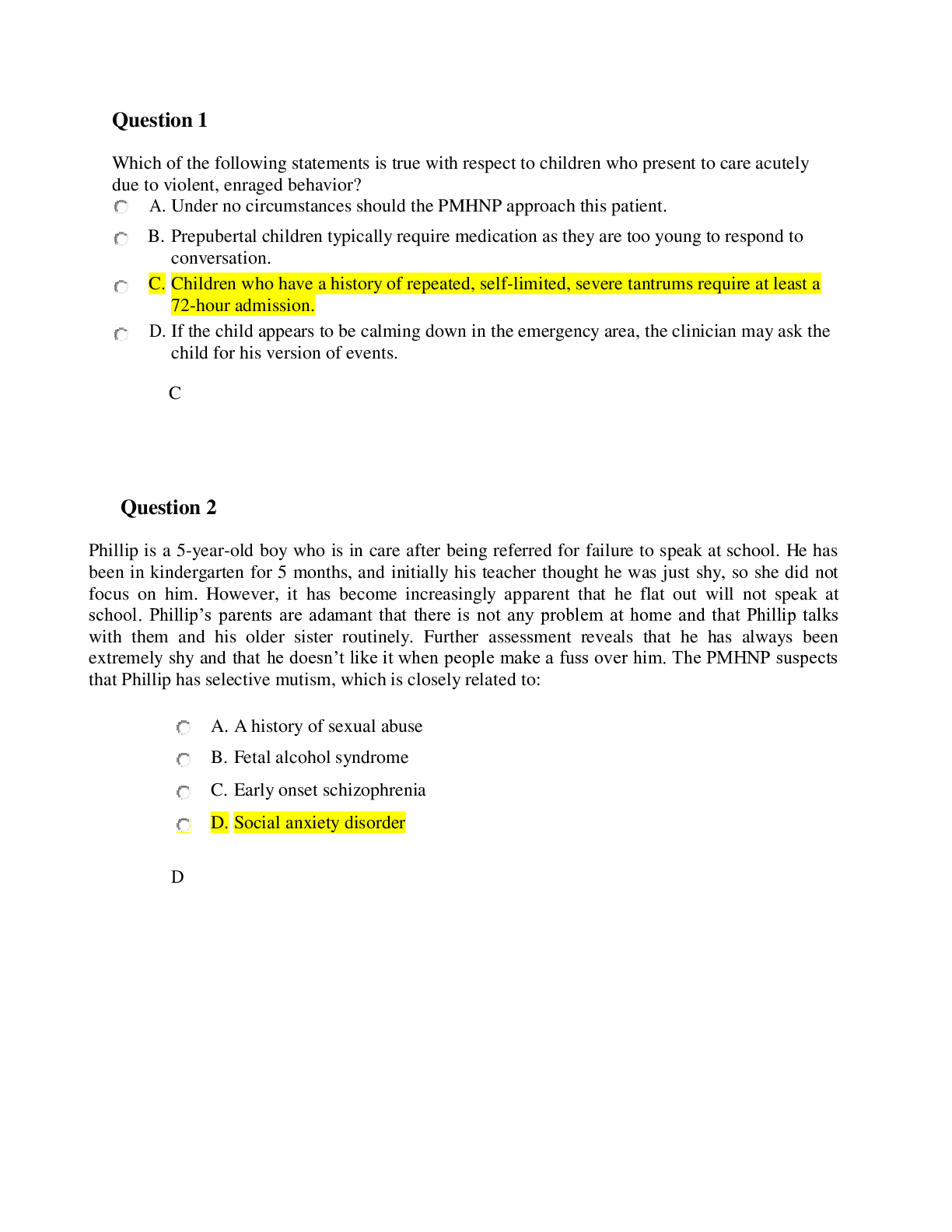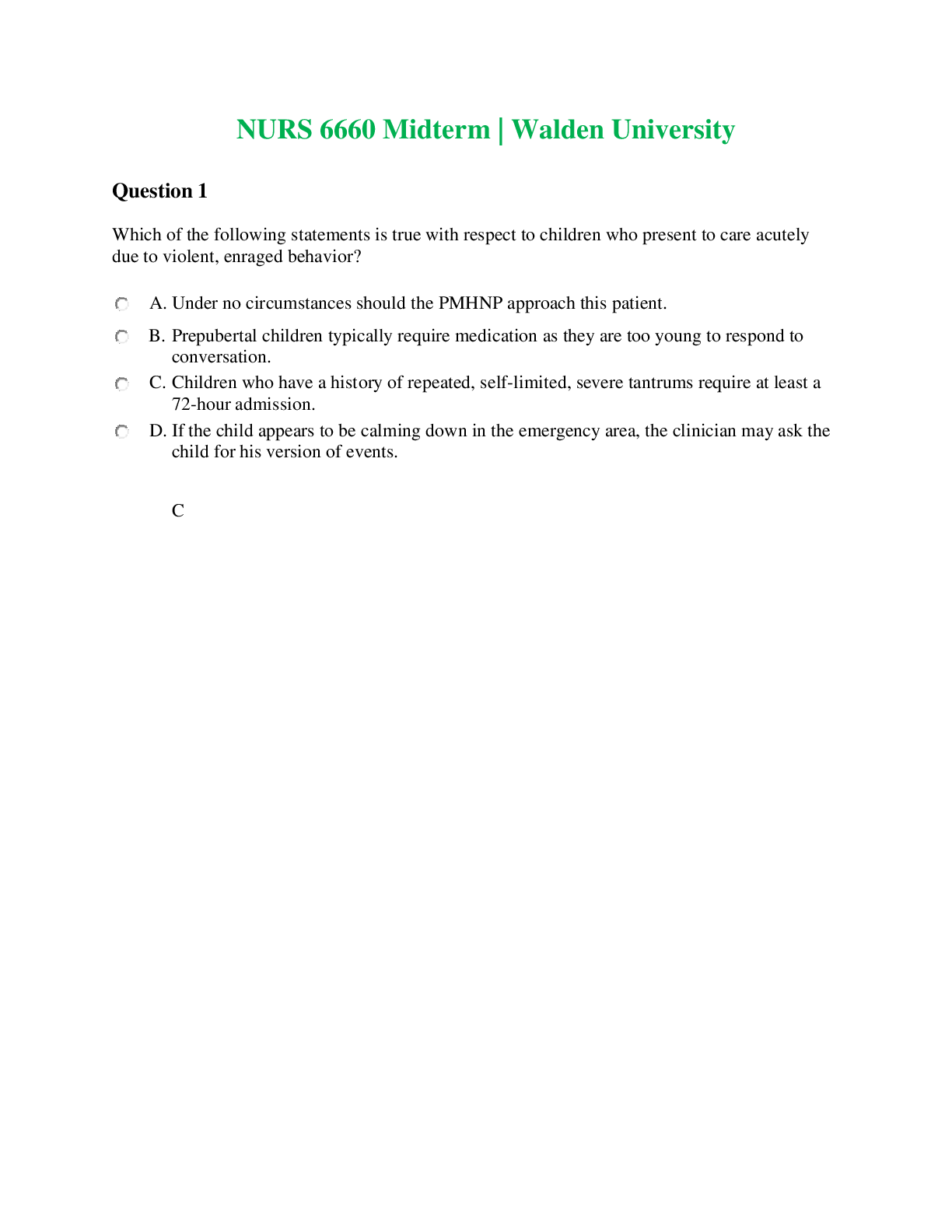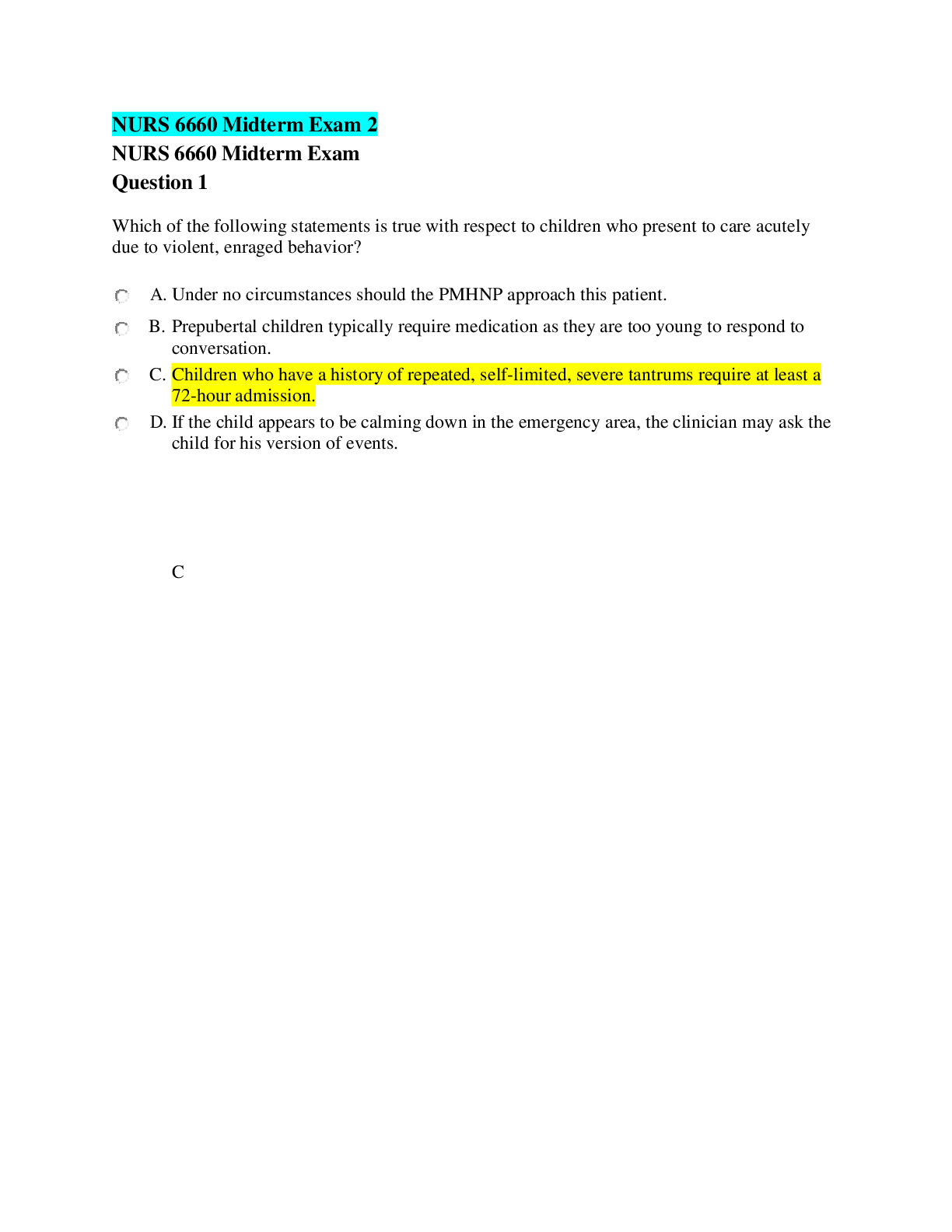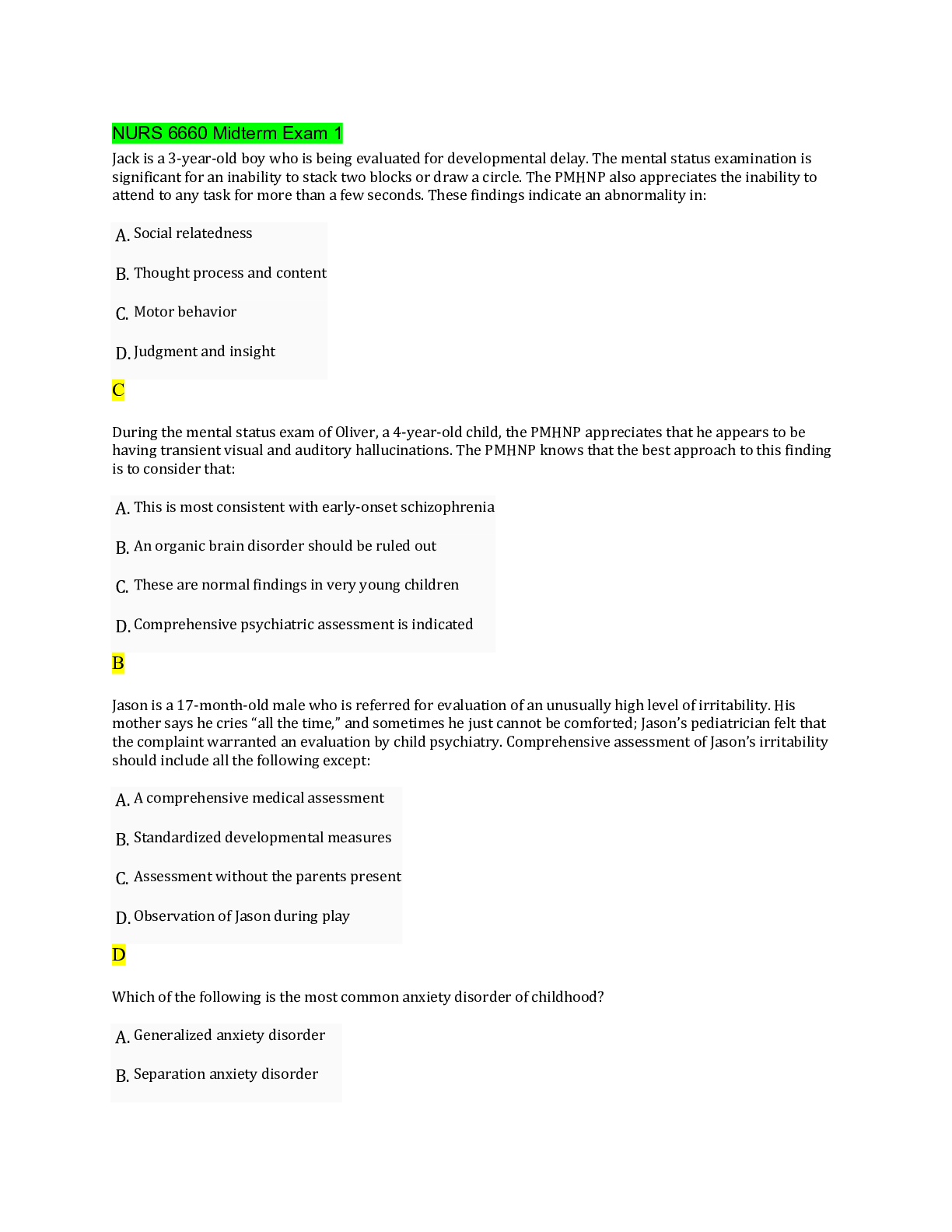Health Care > EXAM > WALDEN UNIVERSITY NURS 6660 midterm with answers (All)
WALDEN UNIVERSITY NURS 6660 midterm with answers
Document Content and Description Below
Question 1 Which of the following statements is true with respect to children who present to care acutely due to violent, enraged behavior? A. Under no circumstances should the PMHNP approach this ... patient. B. Prepubertal children typically require medication as they are too young to respond to conversation. C. Children who have a history of repeated, self-limited, severe tantrums require at least a 72-hour admission. D. If the child appears to be calming down in the emergency area, the clinician may ask the child for his version of events. C WALDEN UNIVERSITY NURS 6660 midterm with answers Question 2 Phillip is a 5-year-old boy who is in care after being referred for failure to speak at school. He has been in kindergarten for 5 months, and initially his teacher thought he was just shy, so she did not focus on him. However, it has become increasingly apparent that he flat out will not speak at school. Phillip’s parents are adamant that there is not any problem at home and that Phillip talks with them and his older sister routinely. Further assessment reveals that he has always been extremely shy and that he doesn’t like it when people make a fuss over him. The PMHNP suspects that Phillip has selective mutism, which is closely related to: A. A history of sexual abuse B. Fetal alcohol syndrome C. Early onset schizophrenia D. Social anxiety disorder D Question 3 Jason is a 17-month-old male who is referred for evaluation of an unusually high level of irritability. His mother says he cries ―all the time,‖ and sometimes he just cannot be comforted; Jason’s pediatrician felt that the complaint warranted an evaluation by child psychiatry. Comprehensive assessment of Jason’s irritability should include all the following except: A. A comprehensive medical assessment B. Standardized developmental measures C. Assessment without the parents present D. Observation of Jason during play D Question 4 Treatment of abused children is multimodal and long term. The single most important aspect of treatment is: A. Establishing a safe place for the child B. Exposure related to the feared experience C. Psychoeducation D. Cognitive-behavioral interventions D Question 5 Having child and adolescent patients rate their feelings and moods on a scale of 1–10 is most effective in which age group? A. 18-months to 3 years B. 3 to 5 years C. 5 to 11 years D. 12 to 17 years C Question 6 The PMHNP is evaluating his data for the assessment of Eric, a 23-month-old male who was referred because he is having nightmares to the extent that most nights he is waking up family members with his crying and screaming. In addition to the clinical interview with the parents and patient, developmental assessment, and standardized tools, the assessment should include: A. Review of a video recording of a nightmare event and Eric’s immediate response B. Age-appropriate interview, e.g., ―If you had three wishes, what would they be?‖ C. Observation of Eric in a playroom where he is unaware that he is being watched D. Partially open-ended questions that provide some focus but allow expression of feeling A Question 7 What is the primary diagnostic difference between obsessive-compulsive disorders in children as compared to adults? A. Age of onset B. Response to treatment C. Recognition that the thoughts or behaviors are irrational D. The thoughts or behaviors occupy > 1 hour daily A Question 8 Psychiatric assessment of children and adolescents is best achieved by a combination of tools and techniques best suited to the child’s age and developmental stage. When interviewing a 10-year-old, the PMHNP may have the best success by having the patient: A. Talk with the examiner via dolls B. Respond to open-ended questions C. Draw family members and peers D. Complete an MMPI B Question 9 The clinical interview is an important part of psychiatric assessment and should be conducted early in the diagnostic process. However, a comprehensive assessment should include other information-gathering modalities because the clinical interview: A. Does not offer flexibility in understanding the evolution of the problem B. Frequently deemphasizes the influence of environmental factors C. May not systematically cover all psychiatric diagnostic categories D. Creates a dialogue in which patients cannot give subjective responses C Question 10 Comprehensive psychiatric assessment ultimately requires the integration of biological predisposition, psychodynamic factors, environmental factors, and life events. These factors, along with a mental status exam, developmental assessment, and any appropriate standardized testing is collectively referred to as: A. Neuropsychiatric assessment B. Biopsychosocial formulation C. The Physical and Neurological Examination of Soft Signs (PANESS) D. Kaufman Assessment Battery for Children B Question 11 Caleb is a 10-year-old boy who is referred for assessment because he is not following any of the rules of discipline at home. His parents report that they have had three separate nannies resign in the last 4 months because Caleb is unmanageable. This is a long-standing problem, going back to daycare even before kindergarten. The PMHNP knows that when conducting her initial interview of Caleb she should: A. Anticipate that he can tolerate up to a 45-minute session B. Consider that symbolic play with dolls will be informative C. Interview him alone before involving the parents D. Be clear that he is there because of problem behavior Question 12 Comprehensive psychiatric/mental health assessment of children includes an interview with the parents or caregivers. Which of the following is not a true statement with respect to the parental interview? A. The parents’ own emotional adjustments should be determined. B. The parents are usually more aware of symptoms than the child. C. The parents may prefer to speak with the PMHNP separately. D. The parents’ upbringings are relevant to the child’s diagnosis. B Question 13 Karen is a 7-year-old girl who has been started on atomoxetine 18 mg once daily for ADHD, which is just under the recommended starting dose of 0.5 mg/kg/day. After just 1 week, her parents report that she is not eating, complains of stomach pain almost every day, is having trouble sleeping, and is ―really cranky.‖ Her teacher says she never seen anything like it; that Karen is actually worse on her ADHD medication. A careful review reveals that Karen is taking her medication just as prescribed. She is not on any other prescribed, over-the-counter, or herbal medications. The PMHNP considers that: A. These are common in the first weeks of therapy and the dose should be increased to a therapeutic regimen B. Karen may be a poor metabolizer of CYP2D6 medications and will need a change of therapy C. Behavioral modalities should be started as optimal management of ADHD is multimodal D. Fluoxetine should be added to the regimen as it has demonstrated efficacy with coincident anxiety Question 14 When treating anxiety disorders in young children, cognitive behavioral therapy (CBT) is preferred as initial treatment if the child is able to function sufficiently to engage in daily activities while in treatment. Which of the following therapies is appropriate for those children too young to engage in traditional CBT? A. Selective serotonin reuptake inhibitors (SSRI) B. SSRI in combination with CBT C. Coaching Approach behavior and Leading by Modeling (CALM) D. CALM in combination with a first-generation antihistamine A Question 15 Adam is a 26-month-old boy referred by his pediatrician for evaluation of speech delay. He has not spoken any intelligible words. Adam is an only child, and the parents deny any contributory medical history. Adam was delivered at 38 weeks 5 days’ gestation without complication. At 5 weeks of age he developed respiratory failure due to respiratory syncytial virus (RSV) and was hospitalized on a ventilator for several days; since then, the parents report only the occasional upper respiratory virus. They report that Adam is a ―really good‖ child and will often entertain himself for periods of time with his building blocks; rarely he will have a ―temper tantrum.‖ The parents confirm that Adam does not speak any recognizable words. While he does make sounds, his parents admit that he does not appear to be trying to communicate with them. When considering a diagnosis of autism spectrum disorder (ASD), the PMNHP would expect further history and examination to reveal: A. The presence of imaginary play B. A failed hearing test C. Exaggerated response to minor injury D. Notable decrease in attachment behaviors D Question 16 Comprehensive psychiatric assessment of young school-aged children requires a variety of information sources. Input is necessary from parents, caregivers, and teachers because children of this age group cannot reliably provide information about: A. Their own fears and anxieties B. Psychotic episodes they have experienced C. The chronology of symptom presentation D. Episodes of mood extremes C Question 17 Mark is a 5-year-old boy brought in for evaluation because his behavior at school has become so disruptive. According to the parents, Mark’s teacher says he just refuses to follow the rules of the classroom, openly defies her, and actually seems to try and upset his classmates. The teacher says Mark gets frustrated very easily when he cannot complete a task and is resistant to any effort to help him. This happens almost every day, and the teacher has indicated that she will not be able to keep him in the classroom if things do not change. Mark’s parents admit that he has always been ―willful‖ and difficult to manage, but as he is an only child with a stay-at-home mom, the family overlooked his disruptive tendencies and accommodated Mark. The parents report that they often skip social events and family outings because they don’t know how Mark will behave. While counseling Mark’s parents about the theories of causation of oppositional defiant disorder (ODD), the PMHNP tells the parents that psychiatric theories include all of the following except: A. Unresolved conflict as a fuel for aggressive behavior targeting authority figures B. The concept that oppositionality is a reinforced, learned behavior in which the child exerts control over authority figures C. A maladaptive response to parents’ modeling of conflict avoidance as manifested by even-tempered responses to parent-toddler struggles D. That the behavior is reinforced by increased parental attention in response to the undesirable behavior C Question 18 Trauma-focused cognitive behavior therapy is a CBT approach characterized by 10–16 sessions comprised of four components: (1) psychoeducation, (2) stress inoculation, (3) gradual exposure, and (4) cognitive reprocessing. This is a management strategy for posttraumatic stress disorder (PTSD) that is: A. Most effective when paired with eye movement desensitization and reprocessing (EMDR) B. Considered by experts to be the first-line management approach for treatment of PTSD symptoms C. Very effective in individuals but generally not recommended for group treatment, e.g., school-based traumas D. Gaining widespread acceptance as a first-line management strategy for other forms of anxiety disorders B Question 19 Being Brave: A Program for Coping With Anxiety for Young Children and Their Parents is a manualized intervention for anxiety disorders in young children between the ages of 4 and 7 years old. It uses a combination of parent-only and parent-child sessions and demonstrates significant improvement in children with all forms of anxiety disorders except: A. Separation anxiety B. Social anxiety C. Generalized anxiety D. Specific phobia C Question 20 During the mental status exam of Oliver, a 4-year-old child, the PMHNP appreciates that he appears to be having transient visual and auditory hallucinations. The PMHNP knows that the best approach to this finding is to consider that: A. This is most consistent with early-onset schizophrenia B. An organic brain disorder should be ruled out C. These are normal findings in very young children D. Comprehensive psychiatric ass [Show More]
Last updated: 2 years ago
Preview 1 out of 39 pages

Buy this document to get the full access instantly
Instant Download Access after purchase
Buy NowInstant download
We Accept:

Reviews( 0 )
$15.00
Can't find what you want? Try our AI powered Search
Document information
Connected school, study & course
About the document
Uploaded On
Sep 05, 2022
Number of pages
39
Written in
Additional information
This document has been written for:
Uploaded
Sep 05, 2022
Downloads
0
Views
64












